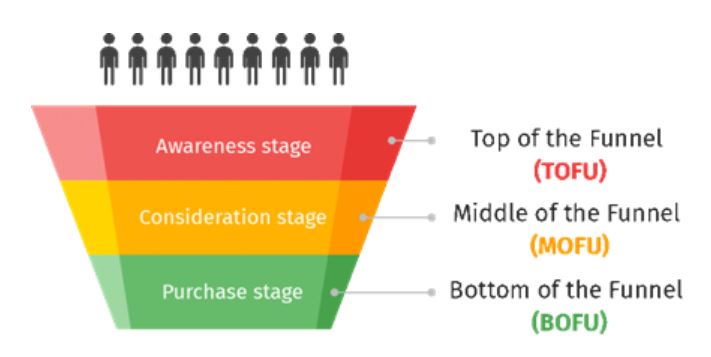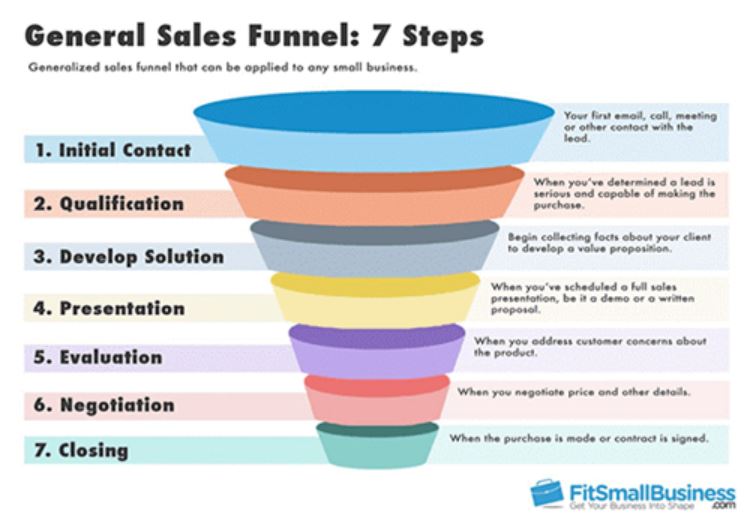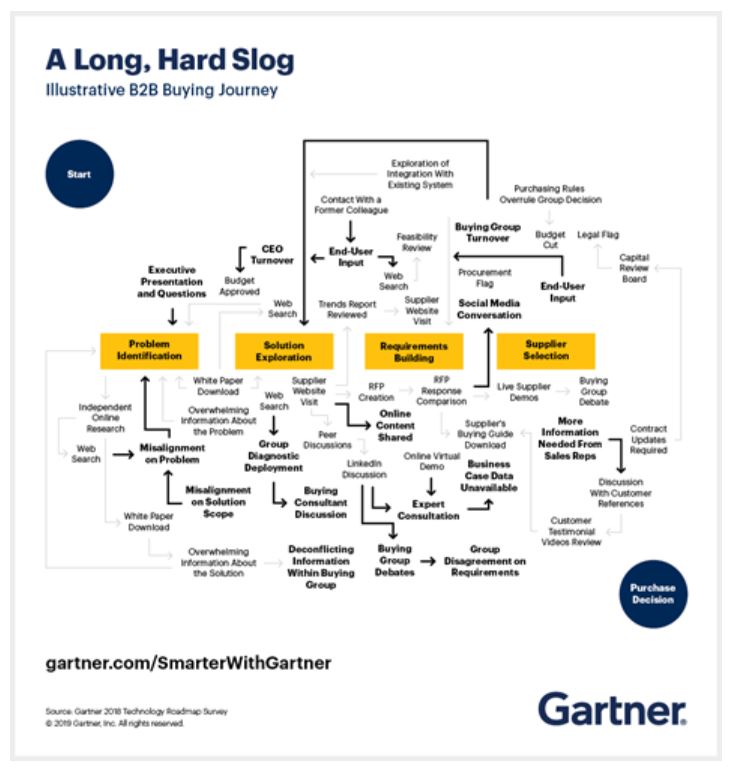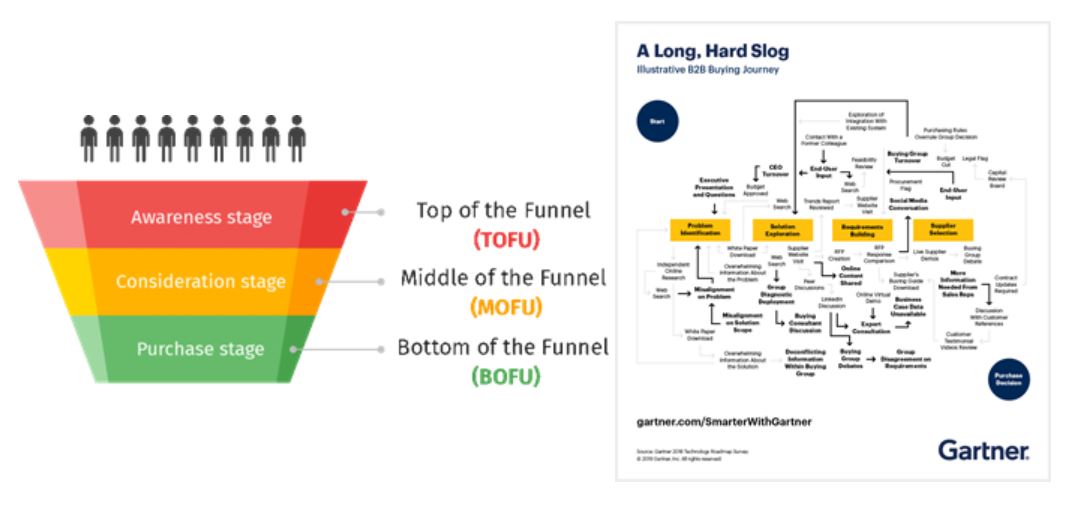The Sales Funnel Is Not The Buyer's Journey

By Abby Sorensen, Editor
The sales funnel is not the buyer’s journey.
It’s not.
No matter how badly we want our buyers to trickle cooperatives through our funnels, they won’t. Because the sales funnel is not the buyer’s journey.
Here it is one more time, a little louder for those in the back: The sales funnel is not the buyer’s journey.
We’ll use a lot of pictures to explain why. Here it goes.
First, there was a time when the funnel worked. When buyers needed sales reps to give them information. When B2B purchasing was less complex. When Google didn’t exist. That simpler world looked something like this (courtesy of Single Grain):

Sales reps still plead with marketers to only send them leads at the bottom of the funnel. And marketers do their best to find those leads through gating content and overinvesting in trade shows (well, when there were in-person trade shows).
Back then, by the time a lead came calling or strolling up to a booth, all sales had to do was not screw it up. But then leads stopped calling, and they stopped answering, too, and no one can walk up to a booth during this pandemic.
Times have changed. Sales reps and marketers are no longer gatekeepers of information (although many still think they are by putting form-fill gates on too much of their content). Today, almost all the information a buyer could possibly want is just a tap, click, and scroll away.
To adapt, some started adding more words and layers to the sales funnel, calling out things like “interest” and “evaluation.” The graphic design work got fancier, and the funnel started looking like an F5 tornado (courtesy of Sheena Jones):

But the fancier sales funnel models didn’t lead to more sales.
Marketers poured more and more leads into the top of the funnel, and sales reps found less and less of those leads making it to the bottom of the funnel. That’s because of this (courtesy of Gartner):

What this shows is that buyers aren’t spending time in traditional sales funnels. Instead, they are spending 83 percent of their time trying to avoid getting trapped in traditional sales funnel. They are doing their own research and forming their own opinions before suppliers are even aware a lead is in the “awareness” stage at the top of the funnel. Today, the sales funnel represents only a tiny, tiny fraction of what actually happens during a B2B purchase.
Research from the CEB published in The Challenger Sale and Harvard Business Review explain this: “Our data shows that customers are, on average, 57 percent of the way through the process before they engage with supplier sales reps.”
Translation: leads in the bottom of your funnel have already made up their mind, and they likely aren’t going with your product/service/solution.
We need to change the B2B sales and marketing vernacular. It’s time to stop saying, “We want leads at the bottom of the funnel.” Leads at the bottom of the funnel are rarely ever sales-winnable leads (unless you are willing to offer deep, deep price cuts).
Instead, it’s time to start saying, “We want leads who are about to start a buyer’s journey.”
Abandon The Sales Funnel, Follow The Buyer’s Journey
The buyer’s journey is not the sales funnel. It is nothing like a linear, simple, funnel-shaped process. “Journey” is an apt word to describe the process. And the apostrophe in “buyer’s” offers an important reminder – the journey belongs to the buyer. The buyer is behind the wheel, the buyer is calling the shots, and the buyer now holds nearly all the power in the buyer-seller relationship.
And this buyer’s journey is often navigated with a broken GPS. With too many people crammed in a car. With endless twists, U-turns, roadblocks, and flat tires. It’s a journey that causes your buyers a great deal of stress, especially when suppliers try to force their way into it without being mindful of the help buyers actually need.
Your buyers are doing something like this during the B2B purchase process (again, courtesy of Gartner):

If that looks complicated, it’s because it is. What we’ve been saying and showing for these last few hundred words is nicely summarized by Gartner:
“Most sales organizations organize activity around a linear pipeline, seeking to move opportunities from one stage to the next until deal closure. This view of deal progression misrepresents the underlying buying reality — which is that the buying process follows anything but a straight line.”
Let’s compare side-by-side. One of these things is not like the other. Sales and marketing like the funnel because they want the path to purchase to be simple.

B2B buying is anything but simple. So if the buyer’s journey and sales funnel are so different, why are they so often confused? And they are confused. Just look at this informal poll conducted by Gerry Moran, global head of social media at Cognizant.

He gives the perfect summary of this article via his comment on the results: “If you are a B2B marketer, you need to create content that maps to the stops on the buying journey and not the sales process!”
So then, how do you create content that maps to the stops on the buying journey and not the sales process? Our answer to that is the Follow Your Buyer content marketing methodology. A shameless plug, yes. But the methodology costs $0 to learn and $0 to implement and $0 to generate sales from. There is no catch, other than the hard work it requires to create and distribute the content.
Following Your Buyer
There are five cyclical stages to Follow Your Buyer: identify your buyer, learn your buyer, help your buyer, engage your buyer, and understand your buyer. You can learn more about those stages here.
Follow Your Buyer bridges the old sales funnel to the new B2B buyer’s journey. It’s a way for suppliers to follow their prospects along the buyer’s journey, interjecting helpful content and commercial insight along the way.
The Follow Your Buyer methodology pairs with this interpretation of the B2B buyer’s journey:

This is adapted from Selling To The C-Suite by Nicholas Read and Stephen Bistritz. The book explains the buyer’s journey as an eight-step process that takes place in three stages (early, middle, and late).
The early, middle, and late stages of the buyer's journey are not parallel to the top, middle, and bottom of the funnel.
That’s important, so we’ll repeat it: The early, middle, and late stages of the buyer's journey are not parallel to the top, middle, and bottom of the funnel.
That’s because the sales funnel starts about the time a buyer starts to examine alternatives, which is near the end of the buyer’s journey.
We take a deeper dive into this iteration of the buyer’s journey elsewhere in the Follow Your Buyer content library (“The B2B Buyers Journey: Explained” and “Understanding The Early, Middle, And Late Stages Of The B2B Buyer’s Journey”). For now, though, we just want to drive home the point that the buyer’s journey is not the sales funnel.
The sales funnel is not the buyer’s journey.
The sales funnel is not the buyer’s journey.
The sales funnel is not the buyer’s journey.
The buyer’s journey starts long before the sales funnel. It’s time to start looking for leads about to start a buyer’s journey, not leads that are already in your competitors’ sales funnels.
